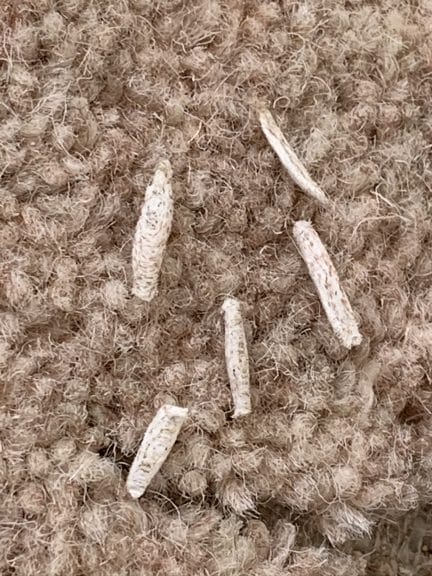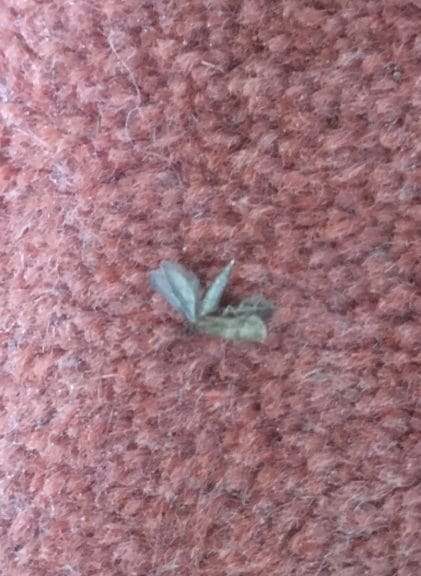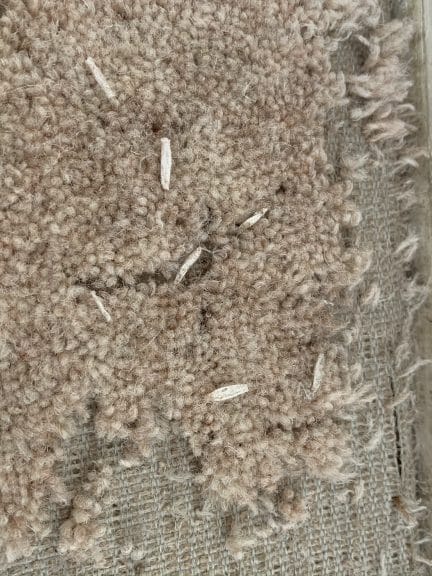(Updated August 2024)
When you’re dealing with any pest, it’s important that you know what species you’re dealing with. When it comes to moths, many homeowners confuse carpet moths and clothes moths and wonder if the two are the same. We’re here to answer this question and help you find the right moth removal treatment.
While there are many other species of moth found in the UK, clothes moths and carpet moths are the ones that cause the most damage and are considered pests.
In addition to explaining whether carpet moths and clothes moths are the same, this blog will also discuss the biology of these pesky insects and signs of moth activity. Once you have identified the problem, we aim to provide you with some self-help methods to resolve the issue so you can get rid of moths for good.
What Is the Difference Between a Carpet Moth and a Clothes Moth?
One common question we often get asked at Pest-Tech is: Are carpet moths the same as clothes moths? They are, in fact, the same species of insect known as the common clothes moth. The reason the two get confused is that infestations can be found on clothes or on the carpet. It is a common pest that lives on natural fibres such as animal fabrics and furs such as wool, silk, leather, feathers or fur.
As such, they can damage not only clothes and carpets but also furniture, rugs and curtains, leaving small holes in the fabric that can quickly develop into major damage. They are often colloquially known as clothes moths or carpet moths, but they’re both the same pests and will choose their preferred meal depending on what is available.
What Causes Carpet Moths To Enter Your Home?
As mentioned, carpet moths are the same species as clothes moths and will simply choose the fabric they find most plentiful in your home.
Common clothes moths love dead skin cells, so dust and pet dander can attract them. If you don’t keep your home clean and hoover regularly, then this could be a reason why moths have infested your home.
There are several ways moths can make their way into your space. Adult moths can fly in through an open window or their eggs could be trodden into the soles of shoes and enter that way. However they got in, once moths find a food source in the form of your carpets or clothes, they are unlikely to leave of their own accord.

Life Cycle of the Common Clothes Moth
The four stages of the common clothes moth are egg, larvae, pupa and adult. Their total life cycle ranges between three to ten months, but during that time, they can multiply rapidly and cause serious damage. A female mates and will then lay eggs on natural fabrics and can lay as many as 300 eggs during her lifetime. The fabrics she lays her eggs in, such as your clothes or carpets, will act as a suitable food source for the larvae when the eggs hatch. It takes between one to five weeks for moth eggs to hatch, depending on the temperature.
Once hatched, they enter the larval stage, in which the juvenile moths form a silk tunnel to live in. The larva is a small, creamy white caterpillar that develops in two to seven months. The larvae are rarely seen as they come out to feed at night. When developed, they pupate whilst concealed in fabric, which takes between two weeks and two months.
The final stage is the adult moth, which is what we often see. The female does not fly and is seen crawling on the carpet or garment if an infestation is present. The male can fly but more often crawls like the female. Adult moths do not feed, and their life span is very short. What many people don’t realise is that the larvae are the stage that does all the damage as they eat the natural fibres. Temperature plays a big part in the development speed of the moth life cycle. Also, the quality of the food affects the size of the moth- generally speaking, the more food available, the bigger the moths in your home. You can find out more about the lifespan of a moth by reading our guide: How Long Do Moths Live?

Signs of Moth Activity
There are three common signs of activity that may indicate a moth infestation is present. The most common is the sighting of fully grown adults. This may be adult males flying around the room or females crawling around the carpet or in amongst clothes. Another sign of moth activity is finding the white silk homes of the larvae. If they are feeding on natural wool carpets, the silk homes may be found at the edge of the room. They are also found under furniture in the shadows, such as on dressers or sofas. Skirting boards are a good place to check, as moths and their caterpillars can crawl into even the smallest of holes between the skirting board and the wall. Curtains and curtain ties are other areas that should be checked.

Damage caused by the larvae is the final way to detect activity. Moth larvae are almost constantly eating, and more will be attracted to an area that’s noticably large and provides a good source of nourishment, such as large rugs, wardrobes full of natural fibres or plush carpets. Detecting damage from moths may be as simple as putting on your favourite jumper and noticing holes in it. If this happens, then it is recommended that you check for the other signs mentioned already. If the carpet has been eaten then often the silk houses will be found around the damaged area. You may find this when moving furniture during a spring clean or when deep cleaning your carpets. If any of the signs are found, then you could consider carrying out some self-help to try to eradicate the issue.
DIY Moth Removal For The Common Clothes Moth
So now you know you have a moth infestation, what can you do to deal with the problem? The first thing you must do is establish the extent of the issue. You can do this by carrying out a thorough search of your rooms. Ask yourself are your carpets synthetic or natural wool, they could be a combination. Don’t rule out a room because it has a synthetic carpet, as some moths will eat this. Carry out a check of the skirting board edges, under furniture on the curtains and any soft furnishings. You are looking for any sightings of moths, larvae, silk houses or moth eggs. Check your wardrobes, drawers, and any other clothing storage areas for signs of moths or that their larvae have been eating your fabrics.
Once you have done this and you know where the main problem area is, you can set out to clear the outbreak. If it is a clothes issue and they are in your wardrobe, then you need to remove every garment and wash them. If you have clothes that are too delicate to wash, then you can put them in a bag and put them in the freezer instead. Using a hoover, clean the wardrobe before putting your clothes back in. You can buy moth monitors to place in your wardrobe to see if there is any further activity. Ensure you empty the hoover in an outside bin as you don’t want to infest other areas of your house.
For carpets, you can hoover up, but make sure you move all the furniture. Concentrate on the floor wall junctions at the skirting board. Make sure you empty the hoover in an outside bin again. Moth monitors can be placed again to monitor for any further activity.
Throughout this process, make sure that you are disposing of the inside of your hoover and any debris, such as dead moths or moth eggs, that you’ve collected. This will ensure that you don’t accidentally spread the problem to other rooms and get rid of the infestation effectively.
If these self-help methods don’t work then there may be a requirement for a moth treatment from a professional pest control company such as Pest-Tech.
Consider Professional Common Clothes Moth Treatment From Pest-Tech
So, now you know carpet moths are the same as clothes moths. Hopefully, you will now be confident enough to know how to identify a possible infestation and know how to try to resolve it yourself.
If you’re dealing with a major moth problem, then professional moth control could be the answer. At Pest-Tech, we’re always here to support homes and businesses throughout Maidstone with any pest problem, including moth removal. We carry out moth treatments using chemical intervention that will ensure that these irritating insects are gone for good.
Call 01622 296055 to find out more or book your moth control treatment. We cover the entire Kent area and are ready to help with moth infestations and other pest problems.
